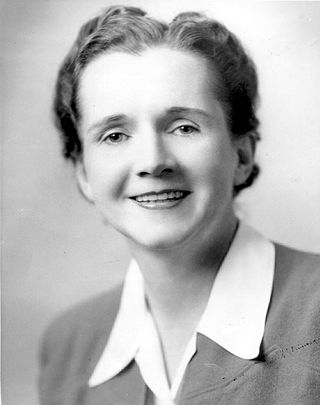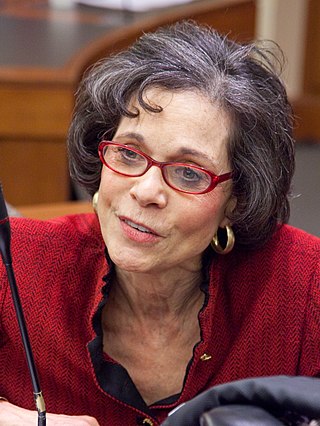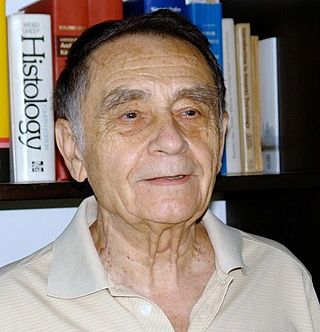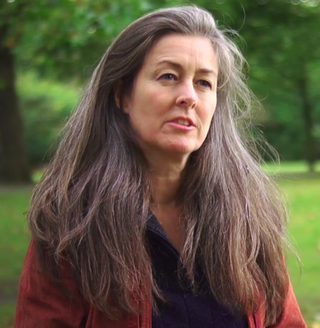
Dichlorodiphenyltrichloroethane, commonly known as DDT, is a colorless, tasteless, and almost odorless crystalline chemical compound, an organochloride. Originally developed as an insecticide, it became infamous for its environmental impacts. DDT was first synthesized in 1874 by the Austrian chemist Othmar Zeidler. DDT's insecticidal action was discovered by the Swiss chemist Paul Hermann Müller in 1939. DDT was used in the second half of World War II to limit the spread of the insect-borne diseases malaria and typhus among civilians and troops. Müller was awarded the Nobel Prize in Physiology or Medicine in 1948 "for his discovery of the high efficiency of DDT as a contact poison against several arthropods". The WHO's anti-malaria campaign of the 1950s and 1960s relied heavily on DDT and the results were promising, though there was a resurgence in developing countries afterwards.

Rachel Louise Carson was an American marine biologist, writer, and conservationist whose sea trilogy (1941–1955) and book Silent Spring (1962) are credited with advancing marine conservation and the global environmental movement.

Silent Spring is an environmental science book by Rachel Carson. Published on September 27, 1962, the book documented the environmental harm caused by the indiscriminate use of DDT, a pesticide used by soldiers during WW2. Carson accused the chemical industry of spreading disinformation, and public officials of accepting the industry's marketing claims unquestioningly.
Susanne Antonetta is the pen name of Suzanne Paola, an American poet and author who is most widely known for her book Body Toxic: An Environmental Memoir. In 2001, Body Toxic was named by the New York Times as a "Notable Book". An excerpt of "Body Toxic" was published as a stand-alone essay which was recognized as a "Notable Essay" in the 1998 Best American Essays 1998 anthology. She has published several prize-winning collections of poems, including Bardo, a Brittingham Prize in Poetry winner, and the poetry books Petitioner, Glass, and most recently The Lives of The Saints. She currently resides in Washington with her husband and adopted son. She is widely published both in newspapers such as The New York Times and The Washington Post, as well as in literary journals including Orion, Brevity, JuxtaProse Literary Magazine, Seneca Review, and Image. She is the current Editor-in-Chief of Bellingham Review.

Dieldrin is an organochlorine compound originally produced in 1948 by J. Hyman & Co, Denver, as an insecticide. Dieldrin is closely related to aldrin, which reacts further to form dieldrin. Aldrin is not toxic to insects; it is oxidized in the insect to form dieldrin which is the active compound. Both dieldrin and aldrin are named after the Diels-Alder reaction which is used to form aldrin from a mixture of norbornadiene and hexachlorocyclopentadiene.

Theodora Emily Colborn was Founder and President Emerita of The Endocrine Disruption Exchange (TEDX), based in Paonia, Colorado, and Professor Emerita of Zoology at the University of Florida, Gainesville. She was an environmental health analyst, and best known for her studies on the health effects of endocrine disrupting chemicals. She died in 2014.
In the early 1960s, an interest in women and their connection with the environment was sparked largely by Ester Boserup's book Woman's Role in Economic Development. Starting in the 1980s, policy makers and governments became more mindful of the connection between the environment and gender issues. Changes regarding natural resource and environmental management were made with the specific role of women in mind. According to the World Bank in 1991, "Women play an essential role in the management of natural resources, including soil, water, forests and energy...and often have a profound traditional and contemporary knowledge of the natural world around them". Whereas women were previously neglected or ignored, there was increasing attention to the impact of women on the natural environment and, in return, the effects the environment has on the health and well-being of women. The gender-environment relations have ramifications in regard to the understanding of nature between men and women, the management and distribution of resources and responsibilities, and the day-to-day life and well-being of people.

The Pesticide Question: Environment, Economics and Ethics is a 1993 book edited by David Pimentel and Hugh Lehman. Use of pesticides has improved agricultural productivity, but there are also concerns about safety, health and the environment.

Devra Lee Davis is an American epidemiologist, toxicologist, and author of three books about environmental hazards. She was founding director of the Center for Environmental Oncology at the University of Pittsburgh Cancer Institute, and is a former professor of epidemiology at University of Pittsburgh Graduate School of Public Health. She has served on several governmental and non-governmental organizations, conducting research and advocacy into effects of pesticides, asbestos, and wireless radiation on human health, especially cancers.
Georgina Downs is a British journalist who is a campaigner on health effects of pesticides. After experiencing chronic illness throughout her childhood and adolescence, she launched a campaign against the use of pesticides in industrial agriculture.

Environmental toxicology is a multidisciplinary field of science concerned with the study of the harmful effects of various chemical, biological and physical agents on living organisms. Ecotoxicology is a subdiscipline of environmental toxicology concerned with studying the harmful effects of toxicants at the population and ecosystem levels.
Living Downstream is a 2010 feature-length true documentary based on the book by ecologist and cancer survivor Sandra Steingraber, Ph.D. The film was produced by The People's Picture Company.
Dr. Wilhelm Carl Hueper, MD was an early pioneer in the field of occupational medicine, and was the first director of the Environmental Cancer Section of the National Cancer Institute, holding that post from 1938 to 1964. He is best remembered as one of the inspirations for author and environmental scientist, Rachel Carson.

Mirosław Jan Stasik was a Polish medical doctor and research toxicologist.

ElizabethLucille Farrier Stickel, was an American wildlife toxicologist and director of the Patuxent Wildlife Research Center from 1972 to 1982. Her research focused extensively on contaminants in wildlife ecosystems, and her research on the effects of the pesticide DDT helped form the basis for Rachel Carson's book Silent Spring. She was also the first woman to become both a senior scientist as a civil servant of the US government and to be director for a national research laboratory.
Elizabeth M. Ward is an American scientist and researcher for the American Cancer Society. She received her PhD in Epidemiology from the University of Pennsylvania. Ward serves as the National Vice President of Intramural Research for the American Cancer Society and Chair of the World Trade Center Health Program Scientific and Technical Advisory Committee. She has held many positions in various cancer research organizations including a position on the National Cancer Institute's Board of Scientific Counselors for Clinical Sciences and Epidemiology. In recognition for her prominent work in the medical research field, she has received two different awards: U.S. Public Health Service Meritorious Service Medal and the Calum S. Muir Memorial Award. Ward's work is heavily centered around "cancer disparities, cancer treatment and outcomes, cancer surveillance, occupational cancer and environmental cancer."
Shirley Ann Briggs was an American artist, photographer, writer, editor, and naturalist. She spent a large portion of her career participating in efforts to inform the public about the environment in regards to synthetic chemicals such as pesticides. A talented artist and writer, Briggs would often use the combination of her understanding environmental hazards with her artistic skills to achieve her goals in regard to environmental education. After graduate school she moved to Baltimore to work for Glenn L. Martin Company as a mechanical arts illustrator and would later move on to work for the U.S Fish and Wildlife Service. She also worked as chief of the Bureau of Reclamation's graphics sections and drew diagrams for the Smithsonian Institution's National Museum of Natural History. After Rachel Carson's passing in 1964 Briggs became the executive director of the Rachel Carson Council between the years of 1970 and 1992. She served as an essential editor and illustrator of a number of Rachel Carson's works.
Ruth Jury Scott was a lifelong environmental activist, naturalist, and conservationist. Scott was a close friend and colleague to Rachel Carson due to their shared passion for educating others about the environment as well as the deadly effects of chemical pesticides. She later served on the executive committee of the Rachel Carson Trust for the Living Environment, Inc.

Pauline Hélène "Polly" Higgins was a Scottish barrister, author, and environmental lobbyist, described by Jonathan Watts in her obituary in The Guardian as, "one of the most inspiring figures in the green movement". She left her career as a lawyer to focus on environmental advocacy, and unsuccessfully lobbied the United Nations Law Commission to recognise ecocide as an international crime. Higgins wrote three books, including Eradicating Ecocide, and started the Earth Protectors group to raise funds to support the cause.
Janette Dexter Sherman was a physician, toxicologist, author, and activist in the U.S. She researched pesticides, nuclear radiation, birth defects, breast cancer, and illnesses caused by toxins in homes and was a pioneer in the field of occupational and environmental health. Sherman was an expert witness or consultant in 5,000 workers' compensation cases about deadly chemicals, contaminated water, and toxic pesticides.











